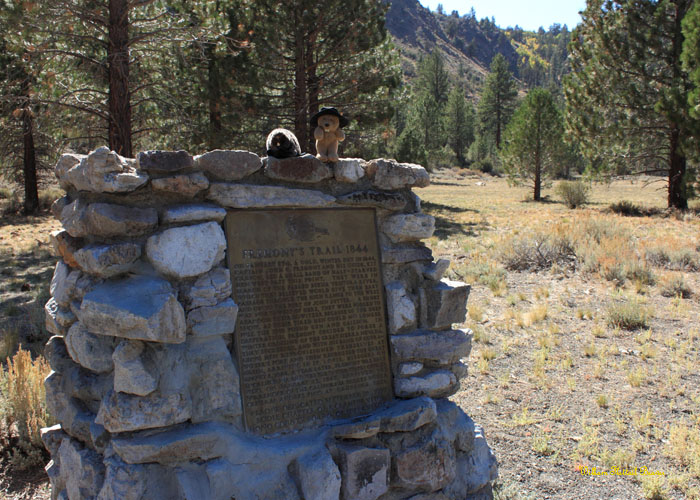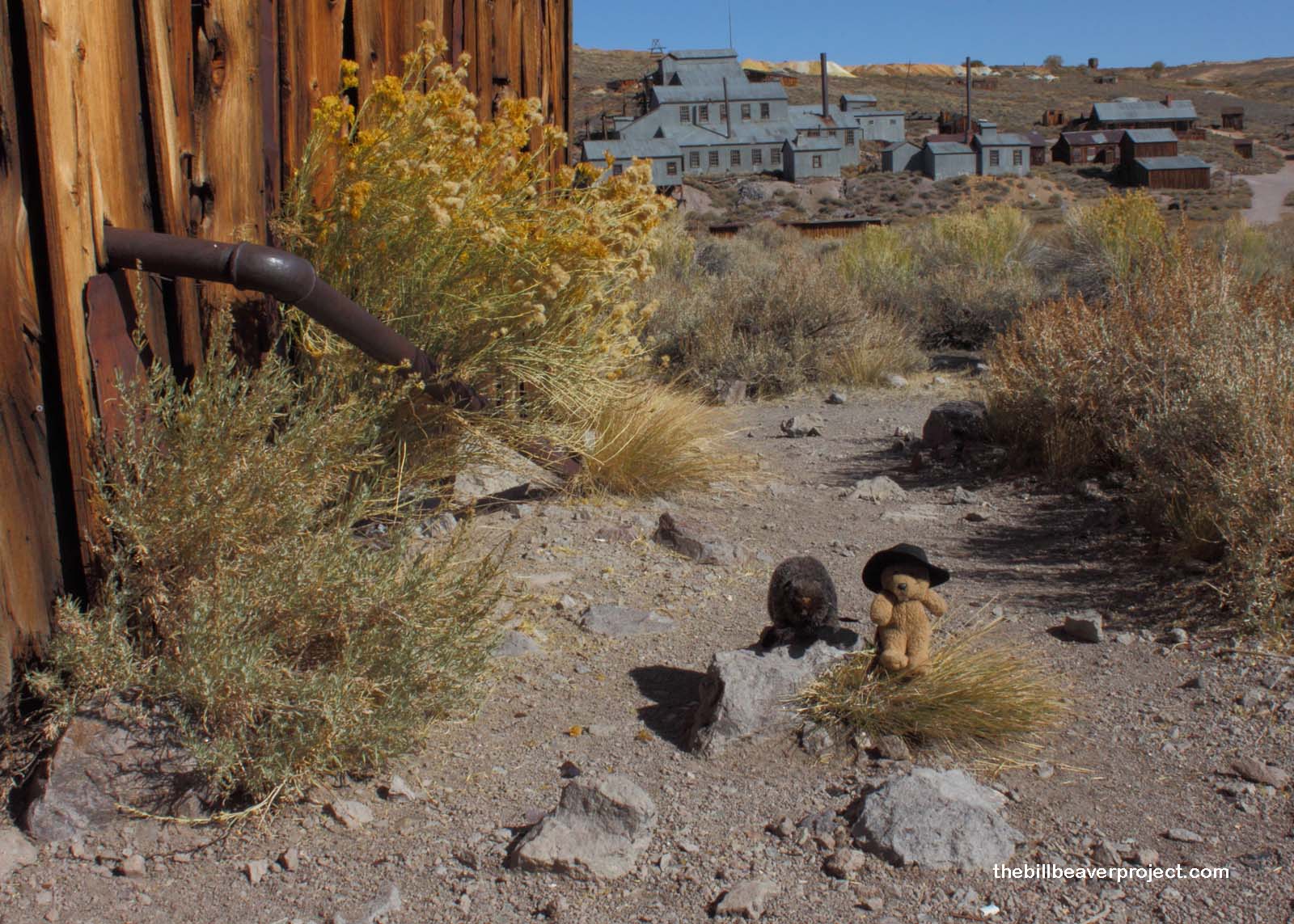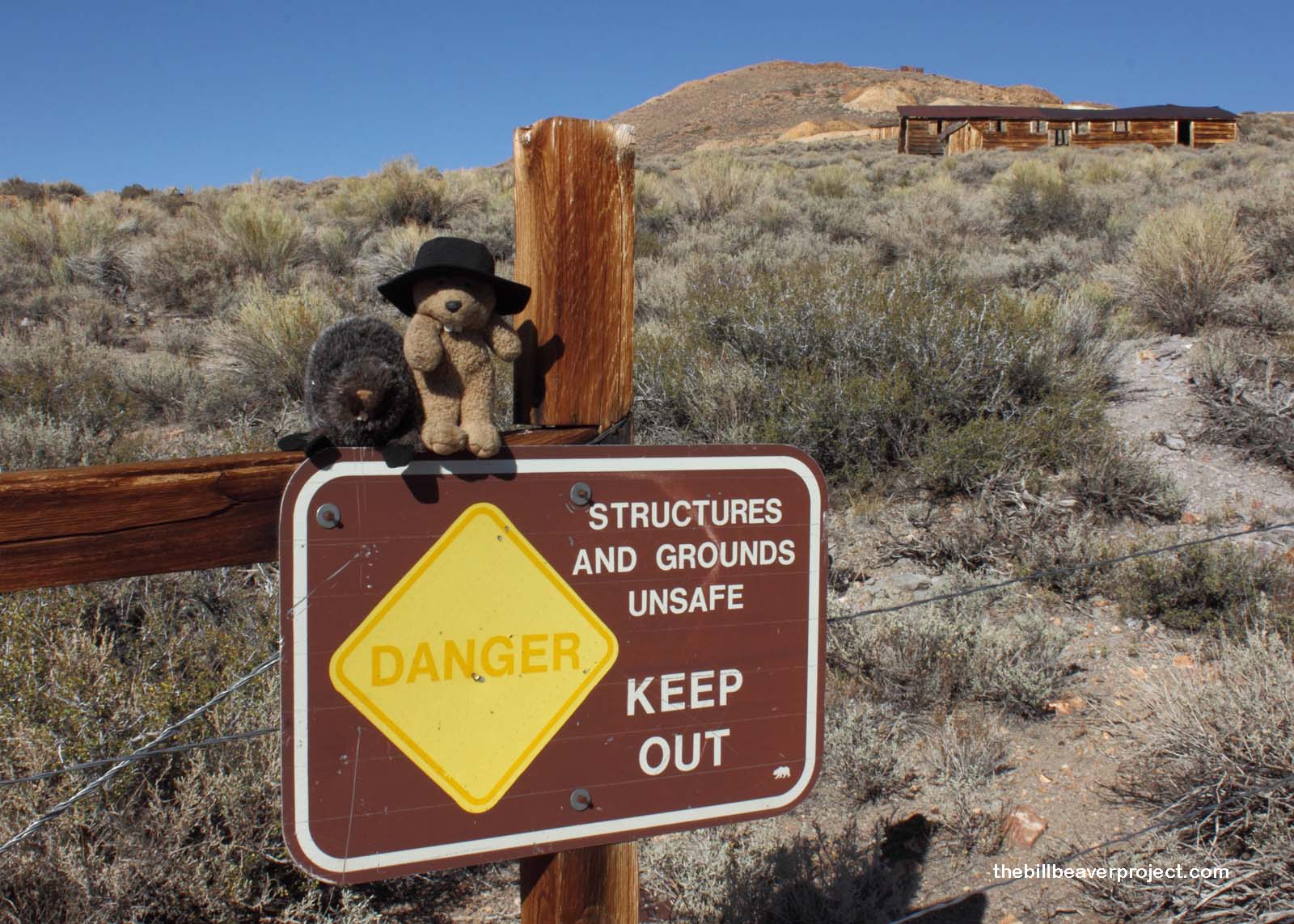Did you know Mono County has just three historical landmarks? I suggested to Woodchuck this morning that we see them all, then conclude at the extraordinary Mono Lake. At first, he was ambivalent to the journey, but when I mentioned the word, “Bodie,” over breakfast in Mammoth Lakes Village, his ears perked up, and he rushed to the car. I guess that means we’re off!
 |
Our first stop was about an hour north, near the town of Bridgeport. The directions were less than specific: Big Bend Mountain Gate Area. To find it, we just kept driving up the 395 until suddenly, on the left, I spotted the plaque for John Frémont’s 1844 Expedition! We squealed over to the side and hopped out to read about how he and his team failed to find the easy way through the mountains, so they left their Howitzer cannon in the snow and plowed through the Sierras to Sutter’s Fort! Good thing too! Without Frémont, California might still belong to Mexico!
 |
Woodchuck was abuzz with anticipation as we retraced our tracks through Bridgeport and up a 13-mile side road to the old mining town of Bodie. As we parked, he jumped out of the car, and his eyes darted across the landscape. What was he searching for? “Gold!” he shouted, pointing to the intact tailings on the hill. True enough, the mines of Bodie had produced $18 million in gold in its first 21 years! Accounting for inflation since 1888, that equals about $441 billion in 2012 dollars! As I processed this sum, Woodchuck was already bounding toward the hills!
 |
At first sight of the tailings, I thought Bodie must have been a placer mine like Malakoff Diggins, but I later learned it extracted gold from quartz, more like the Eureka Mine! After transferring the gold ore from the mine to the mill via Andrew Halliday’s fabulous gondola system, workers fed it into a crushing machine called a “grizzly,” because it was designed in units of measurement equal to the distance between a grizzly bear’s claws! Why not inches? I’ll bet bears were more common than rulers in Bodie!
From there, they ground the ore into powder, mixed it with water, and poured it onto zinc plates painted with liquid mercury. The gold stuck to the mercury on the plates, while the rest of the ore washed away. The mercury was then heated and evaporated, leaving behind the gold, ready for smelting! The chemistry is awesome, but just thinking about mercury vapor made me short of breath!
 |
When I finally caught up to Woodchuck, he was shaking his paw at the fence separating him from his new fortune. Even though I pointed out that he had no mining equipment or experience anyway, he was inconsolable. Safety warnings like these are a modern addition to Bodie, famous for its population of “Badmen,” like Mike McGowan, who bit off peoples’ ears, noses, and thumbs! Consequently, residents developed a habit of asking “Do we have a man for breakfast?” each morning, meaning, “Was anyone killed last night?”
Surprisingly, despite the high death rate in Bodie, there was surprisingly little crime against innocent people! Most of the breakfast club consisted of men who had fought, and lost to, other men, over insults or liberties taken with desirable women. That being said, women, as a rare and precious demographic in Bodie, were treated pretty well. Theft, too, was surprisingly uncommon, largely because mining companies would craft gold bars too heavy for robbers to carry away on horseback! So, much of Bodie’s rough history has been embellished over the years, making this a real town of tall tales and ghost stories!
 |
Though one of the best preserved ghost towns in the country, the Bodie of today only accounts for 5% of the original town, a huge settlement with neighborhoods and districts and 65 saloons! All of these buildings have been standing since the mid 19th century with many original items still rusting inside! Considering this town was able to find enough water in the middle of a desert to support both mines and over 8,000 residents, not to mention electrify the town with a 12-mile power line, I left feeling far richer for the visit! I wondered about Woodchuck, though.
 |
My big brother was pretty quiet as we headed for our final destination, stopping quickly at the triple plaque of Dog Town. This last Mono County landmark fit his mood, a town founded by excited miners jumping on a claim rumored to be overflowing with gold, whose dreams deflated within a few years. Across California during the Gold Rush, lots of these “dog towns” rose and fell this way when prospective mother lodes turned out to be naughty child lodes instead. Their remains are a good reminder to dream flexibly and adapt, adapt, adapt!
Like these miners, it was time for us to abandon these diggins. With mere inches between the sun and the Sierras, it was high time to head down through Lee Vining to the South Tufa Grove of Mono Lake! No one knows for sure where Mono Lake (or County) got its name. “Mono” was not in the vocabulary of the original inhabitants, the Kutzadika’a. It’s believed to be a Yokut word meaning “fly eaters,” because the Kutzadika’a loved to harvest and eat alkali fly pupae from the lake. In any case, gold rushing prospectors drove away or crushed the area’s native cultures before anyone thought to ask. As usual.
 |
With the native people gone, the tallest residents of the lake shores are the tufa formations, limestone towers that formed when calcium carbonate precipitated out of the mineral-rich waters. They were submerged until 1941 when the Los Angeles DWP diverted the lake’s tributaries to supply the growing city with water. That cut the lake level in half, boosted its salinity, and exposed the tufa.
 |
It is a shame what has been done to the lake over the years—the Mono Lake Tufa State Natural Reserve was on the list of 70 state parks slated for closure this year—but I was astonished at the effect the exposed tufa had on Woodchuck. His whole mood brightened, and, not minding the swarms of uneaten alkali flies, he kept saying “Wow” and “Amazing” as the angle of the sun cast these otherworldly towers into color and contrast. I think that demonstrates a valuable life lesson: Gold cannot buy happiness, but a golden light sure helps!
So, the sun went down on my first long trip with Woodchuck. Tomorrow, we will return home, and the next day, Woodchuck will return to Beaver, 489 miles to the northeast, with his illegally harvested tree. We did not talk much about George on this trip, but it was still good to be traveling with family. As of now, with Lastleaf over and Solstice celebrations not yet planned, it may be a while until we see each other again. That’s the risk of a traveling lifestyle, but distance also makes those moments of togetherness all the more special!
Until opportunity’s next knock!

